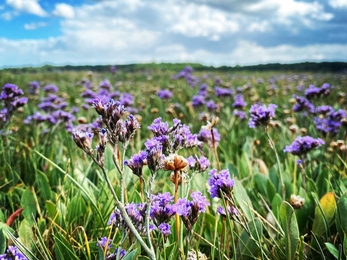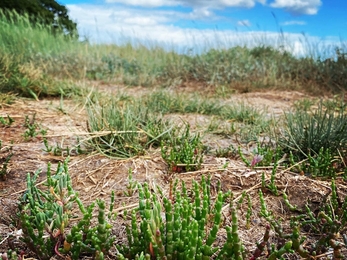Week four of 30 Day Wild – nectar bars, dragonfly hunts, stag beetle stacks and ancient woodlands
Day 22 – To celebrate the start of National Insect Week, Steve Aylward, our Head of Properties and Projects, went moth trapping and was lucky enough to catch 42 individual moths and 19 different species, although he was hoping for a few more and could have possibly caught more if the temperature that evening hadn’t dipped quite as low as it did.
Setting up quite the cat barrier to protect the moths whilst they sat in the moth trap in his garden waiting to be discovered, Steve had blotched emerald, blood vein and buff tip, to name a few, visit overnight. Their names accurately describe these moths and they look beautiful all sat together, these moths seemed to be quite camera confident!
Day 23 – Planting a nectar bar
Day 23 – Continuing our insect theme, it was Jacob Devenney’s turn to share what he’d been up to. Jacob had planted a nectar bar for pollinators, sharing with us what’s on the menu for the insect patrons that would be lucky enough to visit his garden.
With selfheal, ladies bedstraw, greater knapweed, mullein and wild carrot, Jacob hopes that a wide range of pollinator species will visit and be able to fill their boots with nectar.
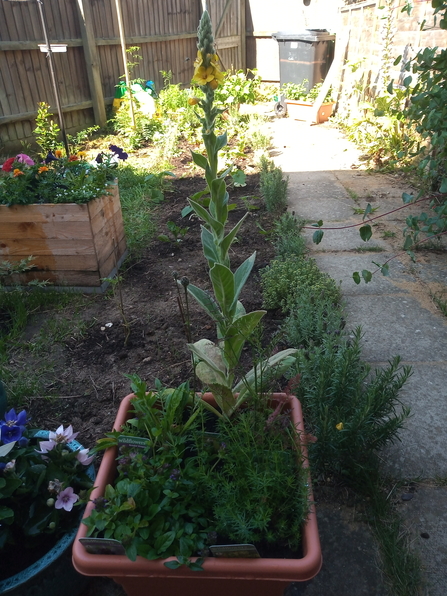
Nectar bar - Jacob Devenney
Day 24 – Dragons and damsels hunt
Day 24 - Alice Wickman, our River Blyth Advisor, went on a search for some of Suffolk’s dragonflies and damselflies species at Hen Reedbeds. Spending the day in the brilliant sunshine without a cloud in the sky, a completely different scene to the one I’m looking out at now this week, Alice managed to find a four spotted chaser, black tailed skimmer and lots of azure damselflies and shared her photos with us from her day spent with dragons!
Day 24 Also saw a report published by The Wildlife Trusts, showing how investing in nature would reap big dividends in tackling the climate crisis.
The report “Let nature help – how nature’s recovery is essential for tackling the climate crisis” draws on the latest research. The report shows how a variety of natural landscapes in the UK can store carbon and could absorb a third of UK emissions if these degraded habitats were to be expertly restored. It makes the case for addressing the climate and nature emergencies together, head on.
The Wildlife Trusts are calling on the Government, industry and local authorities to step-up investment in nature’s recovery and climate change mitigation by:
- Restoring a wide range of land habitats such as grasslands, peatlands and wetlands to store carbon. Government have missed targets to plant trees and help peatlands recover and now must identify, map and protect a wide array of ecosystems and restore them locally as part of a national Nature Recovery Network.
- Restoring nature at sea by introducing effective management for our network of Marine Protected Areas and by designating a suite of Highly Protected Marine Areas. These measures would bring our oceans back to health and enable them to function properly and absorb more human-made CO2 emissions.
The Wildlife Trusts know from experience that restoring nature can help soak up UK emissions whilst also contributing many additional benefits. Just a few examples include preventing coastal erosion, improve people’s health and ensure thriving ecosystems which provide the pollinators, soils, food and water which sustain us.
Nature is, itself, at risk from the climate crisis – yet its potential to store carbon means it can help us address this potential catastrophe.
Read The Wildlife Trust’s full report here.
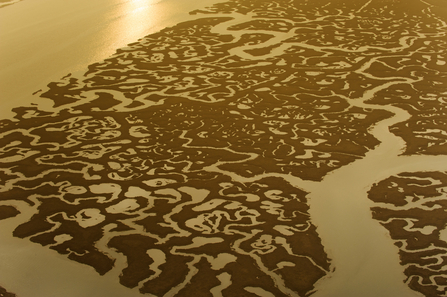
Saltmarsh - Terry Whittaker/2020vision
Day 25 – Building a stag beetle stack
Day 25 -Michael Strand, our Community Fundraising Manager, created a stag beetle stack in his garden with his family using logs to create vitally importantly habitat for stag beetles. Michael buried a proportion of the logs underground so that they will rot down overtime, providing female stag beetles with a place to lay her eggs and the stag beetle larvae with a decaying wood food source for the 3 – 7 years that they are underground.
Taking inspiration from Michael and his family, I posted about stag beetles on my Ipswich page and I have been delighted about the response from the residents of Ipswich, and those further afield in Suffolk. It was great to find out about your stag sightings and hearing that you’ve been logging them on the PTES website, something that is so important as it helps keeps track of population numbers for this endangered species. I received over 70 videos, photos and comments about sightings in your gardens, local parks and green spaces and they’re still coming in!
If you have seen a stag beetle, why not take a moment to record your sighting here
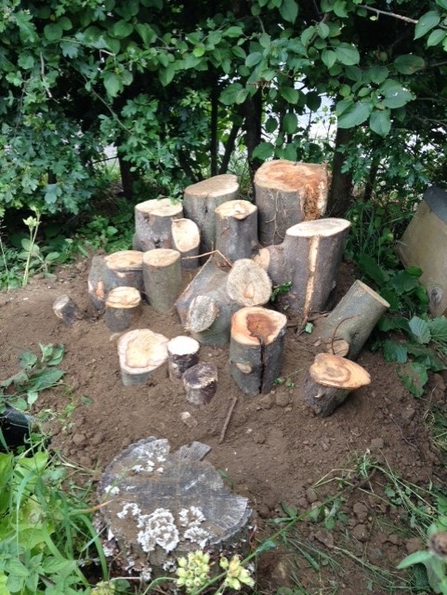
Stag beetle stack - Michael Strand
Day 26 – Wild Reads
Day 26 - With an umbrella at the ready, I took myself outside into the garden for an elevenses break and enjoyed one of our Wild Reads …with a shortbread cookie and iced coffee, I couldn’t resist, in my very own wild place. Having left a large patch of the grass to grow long and having not mown it all year, I sat among the clover and read a chapter, or two outside in the fresh air listening to a particularly vocal blackbird as I did so.
Wild Reads is a partnership project with Suffolk Libraries and aims to give everyone the opportunity to enjoy the very best nature writing and to help inspire and ignite a love of nature in readers through the lenses of a wide variety of writers.
Our booklists consist of titles such as Meadowland by John Lewis–Stempel, Overstory by Richard Powers and The Wild Places by Robert Macfarlane and more. Read how to get involved here including how to request your E-copy of some of our Wild Reads collection here.
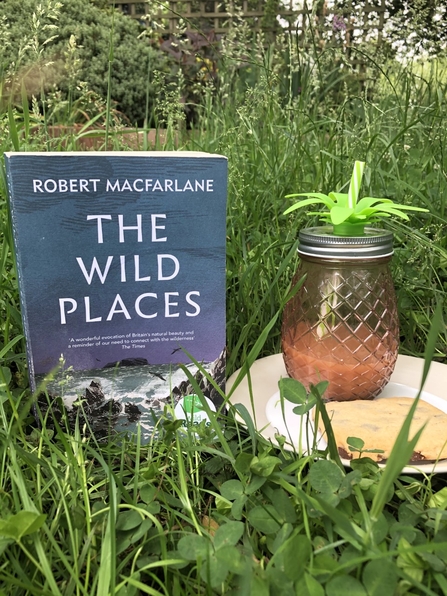
Wild Reads
Day 27 – Elderflower delight
Day 27 - What better way to spend a rainy day than to go foraging? I just had to have a go at making delicious elderflower delight, an alternative to Turkish delight, taking a gamble and hoping there would still be elderflower heads on the trees.
I had been meaning to make this much earlier in the year when elderflowers are at their best, but I was pleasantly surprised to find enough flowers in bloom to make this delicious elderflower delight. Having stumbled across wild raspberries really early on in my dubious foraging trip, I would have gone home happy having sampled a couple straight from the hedge, being delighted to find wild raspberries growing in a different Ipswich park, Bramford Road Open Space, to the one I usually find them in, Holywells Park.
Heading home with enough to make my elderflower delight, having picked just one flower head from a tree at a time, taking only what I needed and leaving plenty for the wildlife, I followed a recipe that I had seen on The Wildlife Trust’s main page, shared from The River Cottage Handbook. You can find the recipe here;
The elderflower delight was delicious and well worth making. the kitchen into a complete sticky mess and redecorating it with icing sugar. Elderflowers will likely be over now but I would recommend this activity for next year! I know I’ll be making it again.
Remember to always forage responsibly and leave plenty for wildlife to enjoy.
Day 28 - Coastal plants
Day 28 – I thought that I would embrace the wind and I headed to the coast to look at coastal plants on Nacton Shores, something that I haven’t done for a while. Usually going most years to visit this location, accessing it through the beautiful ancient woodland, it’s carpeted with thrift, purslane and other plants. The thrift is now gone over but I found carpets of sea lavender with its purple flowers contrasting beautifully against stormy skies.
Sea lavender isn’t a true lavender and so doesn’t share the same powerful smell but it does share the same benefits to pollinators such as bees, wasps, moths and butterflies and so it seemed apt visiting this plant and appreciating as part of National Insect Week. Sea lavender grows well on saltmarshes, creek banks, coastal flats and anywhere muddy on the coast and so therefore suits the very muddy Nacton shores well.
Sprouting up across Nacton’s coast we found common glasswort which is also known as marsh samphire or asparagus of the sea, due to its likeness to asparagus, albeit a being a little saltier.
Its succulent nature is what makes this plant popular to eat and also what allows it to grow so well in difficult conditions. It has been foraged for food for years and also its ashes used to be used to make glass and soap.
Visiting Nacton Shores reminded me of the times that I have been crabbing on the shoreline and has prompted me to revisit this childhood past time with on my wild to do list this summer!
Day 29 – Blustery walks in ancient woods
Day 29 – For the penultimate day of 30 days wild I went for a blustery walk in Ipswich’s ancient woodland, Bridge Wood in Orwell Country Park, and sat and admired one of Ipswich’s oldest resident oaks.
Having walked through this wood only the day before to check out the different coastal plants, I wanted to revisit but this time to spend some time looking at the beautiful gnarled grand old oak that’s sits in this ancient woodland that has been managed continuously as woodland habitat since at least 1600.
This tree is well loved in Ipswich and many people know the tree well having spent many hours climbing it. The structure of this ancient oak it perfect for climbing. It’s almost as if it’s grown that way, inviting people to come and climb it.
We had some lovely stories from you in response to this post too, from someone who was proposed to at this tree and others who have also simply sat and admired it, or avid climbers that have scrambled up it. They were great to hear, thank you for sharing.
I also found some woodland treasures on my walk finding magpie feathers admiring their iridescence and a pine cone eaten by a squirrel (we could tell because it’s missing all of its scales).
Day 30 – What a wild month it’s been
Day 30 – Just like that we are at the end of 30 Days Wild and we can’t quite believe it. Our team have had a great time going wild and doing random acts of wildness across the county and so we thought for the final day of The Wildlife Trust’s biggest nature challenge, we would look back and reflect on a month’s activity.
From guerrilla chalking, searching for nightjars, nightingales, dragonflies, shark’s teeth, creating floral rainbows, stumbling across rare plants, camera trapping, moth trapping, foraging, wild breakfasts and more, we’ve enjoyed going wild these last 30 days and we hope that you have too.
Thank you for joining in and sharing your random acts of wildness with us. We have loved seeing what you’ve been getting up to.
It may be the end of #30dayswild but why not make nature part of your everyday and go wild 365 days a year?
#30dayswild 2020 (https://youtu.be/WZnAI9e2-SI)
#30dayswild 2020






